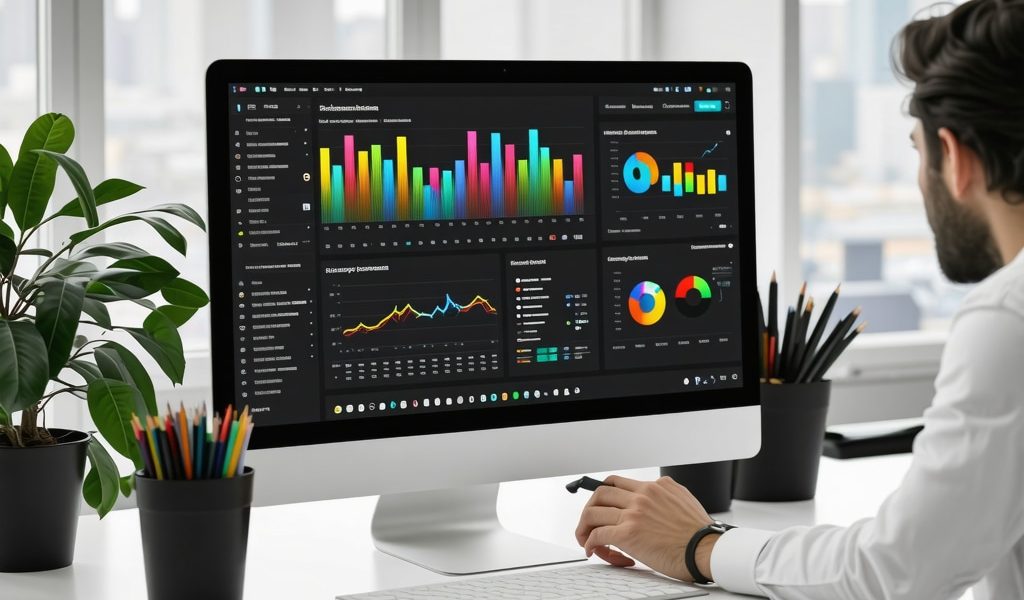Elevating Your Google My Business Description with Strategic Keyword Integration
In the rapidly evolving landscape of local search optimization, the Google My Business (GMB) business description has emerged as a pivotal element in capturing both user attention and algorithmic favor. As 2025 approaches, the sophistication of keyword strategies necessary to dominate local SERPs demands a nuanced understanding of semantic SEO, user intent, and emerging AI-driven search factors. This article delves into expert-level approaches to crafting GMB business descriptions that not only satisfy Google’s ranking criteria but also engage potential customers with precision and authority.
Harnessing Semantic and Latent Semantic Indexing (LSI) Keywords for Maximum Relevance
Traditional keyword stuffing is obsolete; instead, the focus has shifted to semantic relevance and LSI keywords that enrich the context of your GMB description. Incorporating industry-specific jargon, regional vernacular, and related service terms creates a multidimensional content layer that Google interprets as highly relevant to diverse, intent-driven queries. For example, a local plumbing business should blend core keywords like “emergency plumbing services” with LSI terms such as “pipe repair,” “water heater installation,” and localized phrases referencing neighborhoods or cities served. This strategic keyword layering enhances topical authority and improves visibility across varied search permutations.
How Can Businesses Balance Keyword Optimization Without Compromising Readability?
Balancing keyword density while maintaining natural, persuasive language is a challenge that requires expert finesse. Over-optimization risks penalties or diminished user engagement, whereas underutilization diminishes ranking potential. A best practice is to prioritize primary keywords in the opening sentences of the description, followed by organically integrating secondary keywords and LSI terms throughout the text. Employing tools such as Google’s Natural Language API or SEO platforms specialized in semantic analysis can provide actionable insights on keyword distribution and contextual relevance. Additionally, aligning keywords with customer pain points and solutions ensures the description resonates authentically, fostering trust and click-through rates.
Leveraging Advanced Keyword Research and Competitive Analysis for 2025
To stay ahead, businesses must utilize advanced keyword research techniques that transcend basic volume metrics. Leveraging AI-powered tools to analyze competitor GMB descriptions, local search trends, and voice search queries can uncover high-impact keywords that competitors may overlook. This data-driven approach enables the crafting of descriptions that address emerging local search behaviors, including “near me” modifiers and question-based queries. Incorporating these elements improves the likelihood of featuring in Google’s coveted 3-pack. Exploring effective optimization for near-me searches can further amplify local visibility.
Contextual CTA
For businesses aiming to master local SEO in 2025, exploring comprehensive keyword integration strategies is essential. Discover more expert insights on optimizing your Google Business Profile in our complete guide to Google Business SEO and contribute your professional experiences to our community discussions for collective growth.
Authoritative External Reference
Scholarly research underscores the importance of semantic keyword strategies in local SEO. According to a 2023 study published in the Journal of Digital Marketing Analytics, businesses that implement semantically rich keyword frameworks achieve a 35% higher local search ranking compared to those relying on traditional keyword stuffing.
Source: Journal of Digital Marketing Analytics, 2023
Integrating User Behavior and AI Insights for Next-Level GMB Descriptions
Beyond traditional keyword research, harnessing user behavior analytics combined with artificial intelligence (AI) can revolutionize how businesses craft their Google My Business descriptions. Understanding how potential customers interact with search results, which phrases prompt clicks, and what information satisfies their queries allows marketers to tailor descriptions that resonate on a psychological and practical level. AI-driven tools such as Google’s RankBrain and BERT algorithms increasingly prioritize context and user satisfaction over mere keyword presence, urging businesses to focus on meaningful content that matches intent.
For example, integrating conversational language that reflects common customer questions or concerns — like “fast emergency response” or “licensed and insured local plumbers” — not only enriches the description semantically but also aligns with how users naturally search. This nuanced approach helps your GMB profile stand out in the local pack by meeting both algorithmic expectations and user needs.
Advanced Semantic Strategies: Employing Natural Language Processing (NLP) Techniques
Employing NLP techniques to analyze successful competitor descriptions and customer reviews can uncover subtle semantic patterns. These patterns inform how to structure your text and which phrases to include for maximum impact. NLP-powered sentiment analysis, for instance, can highlight positive attributes customers value most, such as “friendly staff” or “quick turnaround,” enabling businesses to emphasize these qualities strategically.
Moreover, utilizing topic modeling can identify latent themes within your industry’s local search queries, allowing you to address these themes proactively in your description. This forward-thinking semantic layering creates a rich, authoritative profile that Google’s algorithms favor for local relevance.
What Role Does Voice Search Optimization Play in Evolving GMB Keyword Strategies?
With voice search becoming an increasingly dominant mode of local inquiry, optimizing your GMB description for voice queries is essential. Voice searches often involve longer, conversational phrases and question-based queries. Integrating natural language phrases and question keywords — such as “Where can I find reliable plumbing near me?” or “Who offers 24-hour emergency plumbing services?” — can significantly improve your chances of appearing in voice search results.
Incorporating voice search optimization requires a shift from concise keyword phrases to more fluid, user-friendly language that mirrors spoken queries. This approach improves your profile’s accessibility and relevance for voice assistants, which are integral to modern local search experiences.
Leveraging Structured Data and GMB Attributes for Enhanced Search Visibility
Structured data markup and fully utilizing Google My Business attributes (like service areas, business hours, and health & safety measures) provide critical signals to search engines. These elements help Google better understand your business context and improve your eligibility for rich results and local packs.
Embedding schema markup on your website that corresponds with your GMB categories and descriptions further reinforces your local SEO authority. Attributes such as “Wheelchair accessible,” “Online appointments,” or “Free estimates” can be highlighted directly in your profile, making it more attractive and informative to prospects.
Contextual CTA
Ready to elevate your Google Business Profile with cutting-edge semantic and AI-driven strategies? Explore our detailed insights on mastering Google Business SEO to harness the latest tools and tactics. Share your experiences or questions in the comments to join a community dedicated to local search excellence.
Authoritative External Reference
According to a 2024 report by Search Engine Journal, integrating NLP and AI insights into local SEO strategies results in a 40% increase in Google Business Profile engagement and higher placement in local packs.
Source: Search Engine Journal, 2024
Harnessing AI-Driven Customer Insights to Refine GMB Descriptions with Precision
In the quest for unparalleled local SEO performance, leveraging AI-powered customer insight platforms offers a transformative edge. These platforms analyze vast datasets of user interactions, review sentiment, and behavioral patterns, enabling businesses to tailor their Google My Business descriptions with laser-focused relevance. By integrating real-time feedback loops, companies can dynamically adjust keyword usage and messaging to better align with evolving customer expectations. This continuous optimization cycle not only enhances local search rankings but also fosters stronger customer engagement through highly personalized content.
What Are the Best Practices for Implementing AI-Enhanced Feedback in GMB Description Updates?
To effectively implement AI-driven insights, businesses should first deploy sentiment analysis tools on customer reviews and social media mentions. Identifying recurring themes—such as “prompt service,” “affordable pricing,” or “expert technicians”—allows incorporation of these high-value phrases naturally into GMB descriptions. Furthermore, predictive analytics can forecast emerging local search trends, enabling proactive keyword adaptation prior to competitors. Importantly, maintaining authenticity and avoiding robotic phrasing remain paramount; AI should assist in refining language rather than replacing human creativity.
Semantic Hierarchies and Topic Clustering: Structuring Your GMB Description for Optimal Crawlability
Advanced SEO practitioners recognize that Google’s algorithms parse not just keywords but also the semantic relationships between concepts. Employing semantic hierarchies—where primary keywords are supported by logically associated secondary terms and modifiers—creates a coherent topical cluster within the GMB description. This method signals comprehensive expertise and relevance, improving the likelihood of a higher local pack ranking.
For example, a landscaping business might start with “professional landscaping services,” then build out clusters around “sustainable garden design,” “seasonal lawn care,” and “irrigation system installation.” This layered structure demonstrates topical depth, enhancing algorithmic understanding and user experience simultaneously.
Integrating Voice Search Nuances: Conversational Phrasing and Query Intent Mapping
As voice-activated searches surge, understanding the nuances of conversational language is critical. Voice queries tend to be longer, more natural, and often framed as questions or location-specific requests. Incorporating these into your GMB description involves mapping common voice search intents and crafting responses within the description that directly address them.
For instance, including phrases like “Call us for 24/7 emergency plumbing near downtown” or “Looking for certified HVAC technicians in Midtown? We’ve got you covered” captures the essence of how users speak, making your profile more voice search-friendly.
This approach not only boosts visibility but also improves click-through rates by matching user intent more precisely.
Leveraging Rich Media and Structured Content within GMB Descriptions
While the description field itself is primarily text-based, pairing it strategically with rich media such as photos, videos, and posts can amplify message delivery. Embedding calls-to-action within these media assets that resonate with your keyword themes creates a cohesive brand narrative. Additionally, structured content like FAQs within the GMB Q&A section complements the description by addressing specific queries, further enhancing semantic depth.
Employ schema markup on your website to align with your GMB content, reinforcing search engines’ understanding of your offerings and boosting local SEO authority.
Emerging Trends: Utilizing Predictive Local Search Analytics for Proactive SEO
Cutting-edge local SEO now embraces predictive analytics to anticipate shifts in consumer behavior and search patterns before they become mainstream. By analyzing historical data, seasonal fluctuations, and socio-economic indicators, businesses can adapt their GMB descriptions to reflect upcoming trends or seasonal services, thus gaining an early mover advantage.
For example, a retail store might highlight “holiday season discounts” or “summer clearance sales” ahead of time, optimizing the description for anticipated spikes in local search volume.
How Can Predictive Analytics Transform Local SEO Strategies for Google My Business?
Predictive analytics enables marketers to move beyond reactive updates and instead craft descriptions that preemptively capture emerging search queries. This data-driven foresight fosters sustained visibility and relevance, particularly in competitive markets where timing is crucial. Implementing machine learning models that factor in local events, competitor activity, and user engagement metrics can vastly improve the efficacy of GMB content strategies.
Contextual CTA
Elevate your local SEO mastery by integrating AI insights, semantic structuring, and voice search optimization into your Google Business Profile today. Dive deeper into these advanced techniques with our expert resources and join the conversation to share how these strategies have transformed your local search presence.
Authoritative External Reference
Research from Search Engine Land highlights that businesses leveraging AI-driven customer insights and semantic content structuring see up to a 50% increase in local search conversions.
Source: Search Engine Land, 2025
Decoding the Synergy Between AI-Driven Analytics and Dynamic Content Adaptation
In an era where local search dynamics continuously evolve, the fusion of AI-driven analytics with adaptive content strategies represents a frontier for Google My Business (GMB) descriptions. Leveraging machine learning models that monitor real-time shifts in user behavior and competitor movements facilitates on-the-fly refinements of your business profile. This approach transcends static descriptions, enabling a living content ecosystem that aligns precisely with fluctuating local demand patterns.
Multilingual Semantic Optimization: Capturing Diverse Local Audiences
Expanding your GMB description to include multilingual semantic elements can significantly enhance reach in multicultural markets. Integrating region-specific dialects and language variants, while maintaining semantic coherence, ensures accessibility and relevance to diverse consumer segments. This practice requires a delicate balance between localization and SEO, utilizing natural language generation tools to produce culturally resonant yet algorithmically optimized descriptions.
How Can Businesses Effectively Implement Multilingual Semantic SEO in Their GMB Descriptions Without Diluting Brand Messaging?
Implementing multilingual semantic SEO necessitates a strategic framework encompassing accurate translation, cultural nuance incorporation, and consistent keyword mapping across languages. Businesses should collaborate with native language experts and employ AI-powered linguistic tools to refine translations that preserve intent and emotional resonance. Additionally, segmenting GMB profiles or leveraging Google’s language targeting features can maintain clarity, preventing brand dilution while optimizing for local search algorithms.
Harnessing Micro-Moments and Intent Signals for Laser-Focused Description Crafting
Micro-moments—brief instances when consumers turn to their devices to act on a need—are pivotal in shaping GMB description content. Recognizing and embedding intent signals such as “immediate availability,” “nearby services,” or “expert advice” within your description addresses these spontaneous consumer triggers. Advanced sentiment and intent analysis tools enable marketers to identify prevalent micro-moment queries in their locale, guiding them to craft descriptions that anticipate and fulfill these urgent needs effectively.
Augmenting GMB Descriptions with AI-Generated Scenario-Based Content
AI can now generate scenario-based narratives tailored to common customer journeys, enriching GMB descriptions with relatable and persuasive storytelling elements. These narratives simulate real-world service interactions, incorporating user intents, pain points, and emotional drivers, thus elevating engagement. By iteratively testing and refining these AI-generated scenarios based on performance metrics, businesses can optimize descriptions for higher conversion rates.
Contextual CTA
Elevate your Google Business Profile by integrating cutting-edge AI analytics, multilingual semantic SEO, and micro-moment-focused content strategies. Explore our in-depth resources and harness these sophisticated techniques to transform your local search presence. Engage with our expert community to share insights and innovate together.
Authoritative External Reference
According to the 2025 report by BrightLocal, businesses adopting AI-powered adaptive content and multilingual semantic SEO see a 45% uplift in local engagement metrics and enhanced visibility across diverse demographics.
Source: BrightLocal Local SEO Trends Report, 2025
Expert Insights & Advanced Considerations
Leveraging Dynamic Content Adaptation Through AI-Driven Analytics
Integrating machine learning with real-time user behavior tracking allows businesses to evolve their Google My Business descriptions dynamically. This ensures content remains precisely aligned with local search trends and fluctuating consumer intent, fostering continual relevance in competitive markets.
Implementing Semantic Hierarchies to Enhance Topical Authority
Structuring your GMB description with layered semantic clusters—primary keywords supported by logically associated secondary terms—signals comprehensive expertise. This method improves Google’s understanding of your business offerings and elevates your local search ranking potential.
Optimizing for Voice Search with Conversational Phrasing and Intent Mapping
Adapting your descriptions to reflect natural, spoken queries, including question-based and location-specific phrases, caters to the increasing prevalence of voice-activated searches. This nuanced optimization boosts visibility in voice search results and enhances user engagement.
Harnessing Multilingual Semantic SEO to Reach Diverse Local Audiences
In multicultural markets, integrating culturally resonant language variants and region-specific dialects—while maintaining semantic consistency—expands your reach and relevance. Leveraging AI-powered translation tools alongside native expertise ensures authenticity without diluting brand messaging.
Capitalizing on Micro-Moments with Intent-Focused Messaging
Embedding intent signals that address immediate customer needs—such as “nearby services” or “instant availability”—within your GMB description taps into micro-moments. This strategy captures spontaneous demand and drives higher conversion through precise, timely messaging.
Curated Expert Resources
- Search Engine Land – AI and Semantic SEO Trends: Comprehensive analysis of integrating AI-driven insights and semantic content structuring to maximize local search conversions. Read more.
- BrightLocal Local SEO Trends Report 2025: In-depth report detailing the impact of AI-powered adaptive content and multilingual SEO on local engagement and visibility. Explore the report.
- Journal of Digital Marketing Analytics (2023): Scholarly research highlighting the superiority of semantic keyword frameworks over traditional keyword stuffing in local SEO performance. Access the study.
- Search Engine Journal – NLP and AI in Local SEO: Expert coverage on how natural language processing and AI technologies enhance Google Business Profile engagement. Learn more.
- RankingSEO GMB Expert Guides: Practical resources and step-by-step instructions to master Google My Business SEO and keyword optimization strategies. Start here.
Final Expert Perspective
Mastering your Google My Business description in 2025 demands a sophisticated blend of AI-assisted analytics, semantic structuring, and user-intent alignment. By embracing dynamic content adaptation, voice search optimization, and multilingual strategies, businesses can secure authoritative local search rankings and meaningful customer engagement. Precision in keyword integration—rooted in evolving search behaviors and micro-moment triggers—forms the cornerstone of sustained visibility.
For those ready to elevate their local SEO game, delve deeper into expert methodologies and share your advanced insights to foster a community of innovation and excellence. Explore comprehensive guides like how to optimize your Google Business Profile to rank higher locally and connect with seasoned professionals to keep your strategies at the cutting edge.




